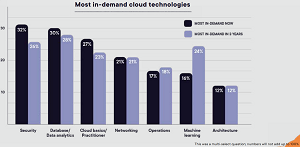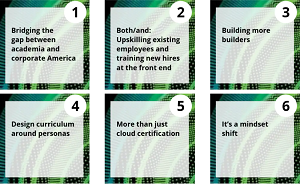News
Cloud Reports Offer Skills Gap Solutions
Two recent "state of cloud" reports offer advice on how to address the everlasting, crippling cloud skills dearth.
The inability to find IT pros with requisite cloud skills is persistently identified as a major challenge to organizations moving to cloud computing, as we have covered in recent articles like "Cloud Strategy Survey Highlights Skills Shortage, Cloud Overspend" and "IBM Cloud Study: 'Initial Excitement' Bends to Skills, Security, Compliance Challenges" and even articles from years ago like this 2018 article, "Report: 'Cloud and Distributed Computing' Are Skills Companies Need Most."
In fact, only 8 percent of global technologists have significant cloud-related skills and experience, says a recent "2022 State of Cloud Report" report from Pluralsight, a technology workforce development company known for its training courses.
That report, like many before it, identifies security skills as the most coveted in this age of rampant ransomware and other cybersecurity threats, though it also highlighted a need for database analytics, networking, machine learning and several other highly sought-after skills.
 [Click on image for larger view.] Most In-Demand Cloud Technologies (source: Pluralsight).
[Click on image for larger view.] Most In-Demand Cloud Technologies (source: Pluralsight).
Pluralsight said security was the No. 1 obstacle preventing organizations from achieving cloud maturity. "When 40 percent of leaders and learners agree that security is the top skills gap, we have a serious problem," the company said in a blog post last month. "That is, unless you want to see your organization's name splashed across the headlines. Cloud computing is the future. That much is clear. But to provide consumers with reliable solutions, we have to prioritize security."
The 8 percent figure mentioned above led off Pluralsight's list of major takeaways from its report:
- 75 percent of leaders are building new products and features in the cloud, but only 8 percent of technologists have extensive experience working with cloud-related tools.
- 64 percent of learners are new to the cloud and looking for basic training.
- 62 percent of leaders implement the latest technologies as soon as they're available.
- Employees are 94 percent more likely to stay with a company that invests in their skill development.
- 71 percent of learners prefer daily or weekly learning opportunities, and 64 percent prefer learning by doing with hands-on tools like labs and sandboxes.
Pluralsight's report compiled survey results from more than 1,000 technologists and leaders in the United States, Europe, Australia and India on the most current trends and challenges in cloud strategy and learning.
A second report, "IBM Transformation Index: State of Cloud," also emphasized how crucial security concerns are. That report is designed to help organizations gauge how they fare against industry and local cloud norms in a variety of cloud areas. IBM said the report is based on its own research with more than 3,000 IT and business decision makers in 12 countries and 23 industries, revealing the areas where teams face the biggest challenges and opportunities. There, of course, security is also front and center, along with the skills gap.
"More than 90 percent of financial services, telecommunications and government organizations who responded have adopted security tools such as confidential computing capabilities, multifactor authentication and others," IBM said in a Sept. 29 blog post. "However, gaps remain that prevent organizations from driving innovation. In fact, 32 percent of respondents cite security as the top barrier for integrated workloads across environments, and more than 25 percent of respondents agree security concerns present a roadblock to achieving their cloud business goals.
"When it comes to managing their cloud applications, 69 percent of respondents say their team lacks the skills needed to be proficient. This, combined with each cloud generating its own operating silo, puts constraints on the efficiency and effectiveness of people's work."
The skills shortage was discussed further in the actual report, which said: "Cloud complexity continues to grow. Many IT teams lack the necessary cloud skills to manage this complexity successfully and will need to reskill, hire for new skills, or 'borrow' skills via free agents in a gig model. Almost seven out of 10 respondents say their organization's IT team lacks the skills to architect or manage cloud applications."
Both reports go into much greater detail about the talent dearth, cloud computing obstacles and much more, while also offering advice to organizations to address those issues.
When it comes to offering solutions to mitigate the cloud skills shortage, Pluralsight unsurprisingly emphasized training, or "upskilling."
To shrink skills gaps and reduce lost internal knowledge, the company said: "Employees need to be aligned with company strategy while they begin to upskill to build within your cloud structure. Institutional knowledge is hard to come by and critical to maintain, which means it's essential that you don't allow critical internal knowledge to leave with an employee if they leave your company. Providing upskilling tools and opportunities is a worthwhile investment, but an investment nonetheless, so take steps to assure it properly benefits your long-term goals."
Pluralsight said organizations can mitigate this risk in a few ways:
- Schedule cloud upskilling times as if they were ceremonies and build in a retrospective meeting for knowledge sharing
- Set up instructor-led training courses for entire teams where specific skills are needed
- Reduce knowledge silos through mentorship, documentation, and cross-team collaboration
- Incentivize employees to upskill through transparent conversations about organizational cloud plans
- Set skip-level meetings for junior-level developers to learn from senior devs
IBM, meanwhile, said that to develop a cadre of cloud-skilled resources and create a single effective hybrid cloud operating model, organizations should consider the following steps:
- Start with defining a strategic workstream on a people agenda
- Empower a cloud Center of Excellence (CoE) to bring the hybrid cloud operating model to life to incubate and hone the necessary skills
- Accelerate execution and empower your people with a skills and experience development program to thrive in the hybrid cloud operating model
Other bullet lists of advice came from our May article, "How to Address Crippling Cloud Skills Shortage?"
 [Click on image for larger view.] Six Fundamental Ways to Address the Cloud Talent Crunch (source: Deloitte).
[Click on image for larger view.] Six Fundamental Ways to Address the Cloud Talent Crunch (source: Deloitte).
That article features the above graphic from Deloitte and bullet lists from that company and others including McKinsey & Company, The Linux Foundation's Clyde Seepersad and others. Here are some samples:
Deloitte:
- Training: Leverage inside or outside training to help provide the required cloud computing skills to existing staffers.
- Hiring: Find net new employees that bring the required cloud computing skills. This could also mean hiring outside consulting or other contract employees.
- Replacing: Consider replacing existing staffers with staff that have the required skills. This may also mean reducing the number of as-is staffers due to the fact that fewer of them may be required for a post-cloud computing enterprise.
McKinsey & Company:
- Find engineering talent with broad experience and skills
- Balance talent maturity levels and team composition
- Build an upskilling program that is extensive, mandatory, and focused on need
- Build an engineering culture that optimizes the developer experience
- Consider using partners to accelerate development, and assign your best cloud leaders as owners
- To keep top talent from leaving, focus on what motivates them
The Linux Foundation's Clyde Seepersad:
- Hire Underqualified Individuals and Train Them
- Advertise Training Opportunities When Recruiting
- Take Advantage of Certification Exams
- Sponsor Scholarship Programs
Dice:
- Hire a Diverse Team
- Invest in Training and Education
- Prioritize Cloud Security
- Hire People Who Can Align Business and Cloud
- Look for Varied Cloud Service Model Experience
Forbes:
- Enable leadership for a cloud-first mindset.
- Establish Central Cloud CoE (CCoE).
- Focus on tech intensity and raise technology quotient.
- Establish cloud innovation hackathons with gamification.
- Adopt hyper-automation and a well-architected framework (WAF).
- Leverage on-demand consultant network.
- Partner with hyperscalers.
- Outsource cloud operations.
- Establish co-innovation labs.
- Find innovative ways to acquire and retain talent.
- Adopt and invest in open source projects and communities.
About the Author
David Ramel is an editor and writer at Converge 360.